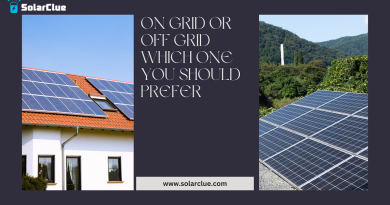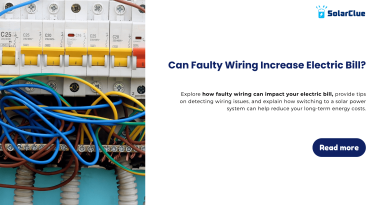Which Is Best Solar Panel In India?
As India moves towards a more sustainable future, many homeowners are considering solar panels to reduce their electricity bills and carbon footprint. This blog will help you understand different solar panel technologies, compare leading brands in India, and choose the best solar panel for your home.
Table of Contents
- 1 Understanding Solar Panel Technologies
- 2 Key Factors to Consider When Choosing a Solar Panel
- 3 Comparing Leading Solar Panel Brands in India
- 4
- 5 Roof Orientation and Energy Consumption
- 6 Government Incentives
- 7 Economic Analysis of Different Solar Panel Options
- 8 Tips for Maximizing Solar Energy Production
- 9 Emerging Solar Panel Technologies
- 10 Conclusion
- 11 FAQs
Understanding Solar Panel Technologies
Monocrystalline
- Efficiency: 15-22%
- Durability: High
- Cost: Higher than polycrystalline and thin-film
- Suitability: Best for areas with limited space and high sunlight exposure.
Polycrystalline
- Efficiency: 13-18%
- Durability: Moderate
- Cost: More affordable than monocrystalline
- Suitability: Ideal for larger roofs and areas with moderate sunlight.
Thin-Film
- Efficiency: 10-12%
- Durability: Flexible, lightweight, lower durability
- Cost: Lowest among the three
- Suitability: Suitable for portable applications and areas with diffuse sunlight.
PERC (Passivated Emitter and Rear Cell)
- Efficiency: 18-23%
- Durability: High
- Cost: Similar to monocrystalline
- Suitability: Good for maximizing energy output on limited roof space.
Key Factors to Consider When Choosing a Solar Panel
Efficiency and Wattage
Solar panel efficiency refers to the percentage of sunlight converted into usable electricity. Higher efficiency panels produce more power and are ideal for homes with limited roof space.
Durability and Cost
Durability ensures the longevity of the panels, with higher quality panels typically lasting 25 years or more. Cost varies by technology, with monocrystalline and PERC panels being more expensive but offering higher efficiency.
Suitability for Indian Climatic Conditions
India’s varied climate demands solar panels that can withstand high temperatures and occasional monsoons. Monocrystalline and PERC panels are generally more suited to these conditions due to their higher efficiency and durability.
Comparing Leading Solar Panel Brands in India
| Brand | Efficiency Range | Warranty | Customer Reviews |
|---|---|---|---|
| Tata Power Solar | 17-20% | 25 years (performance) | High reliability, good service |
| Vikram Solar | 16-19% | 10 years (product), 25 years (performance) | Efficient, durable, good support |
| Waaree Solar | 15-18% | 10 years (product), 25 years (performance) | Affordable, high customer satisfaction |
| Adani Solar | 16-19% | 25 years (performance) | Reliable, cost-effective |
| RenewSys Solar | 15-18% | 10 years (product), 25 years (performance) | High performance, durable |
Roof Orientation and Energy Consumption
Roof Orientation
For optimal performance, solar panels should face south in the Northern Hemisphere. The tilt angle should match your location’s latitude to maximize sunlight exposure.
Energy Consumption
Calculate your average monthly energy consumption from your electricity bills. This will help determine the size of the solar panel system needed for your home.
Government Incentives
The Indian government offers various subsidies and incentives to promote solar energy adoption. Check the Ministry of New and Renewable Energy (MNRE) website for the latest information on incentives available in your state.
Comparison of Solar Panel Technologies
| Technology | Efficiency Range | Cost | Durability | Suitability for Indian Climate |
|---|---|---|---|---|
| Monocrystalline | 15-22% | High | High | High sunlight, limited roof space |
| Polycrystalline | 13-18% | Moderate | Moderate | Larger roofs, moderate sunlight |
| Thin-Film | 10-12% | Low | Low | Diffuse sunlight, portable applications |
| PERC | 18-23% | High | High | High sunlight, limited roof space |
Economic Analysis of Different Solar Panel Options
Initial Investment and Payback Period
- Monocrystalline: Higher initial cost, shorter payback period due to higher efficiency.
- Polycrystalline: Moderate initial cost, reasonable payback period.
- Thin-Film: Lowest initial cost, longer payback period.
- PERC: Similar to monocrystalline, potentially higher ROI.
Example Calculation:
- System Size: 5 kW
- Cost (Monocrystalline): ₹2,50,000
- Monthly Savings: ₹5,000
- Payback Period: ₹2,50,000 / ₹5,000 = 50 months (approximately 4 years)
Tips for Maximizing Solar Energy Production
1. Regular Maintenance: Clean panels periodically to remove dust and debris.
2. Optimal Placement: Ensure no shading from trees or buildings.
3. Energy-Efficient Appliances: Use energy-efficient appliances to reduce overall consumption.
4. Monitoring System: Install a monitoring system to track performance and detect issues early.
Emerging Solar Panel Technologies
Bifacial Solar Panels
- Efficiency: Higher than traditional panels as they capture sunlight from both sides.
- Potential: Suitable for high-reflectivity surfaces, increasing overall energy output.
Perovskite Solar Cells
- Efficiency: Promising high efficiency with lower production costs.
- Potential: Could revolutionize the solar industry with cheaper and more efficient panels.
Conclusion
Selecting the best solar panel for your home in India involves understanding different technologies, comparing leading brands, and considering various factors such as cost, efficiency, and climatic conditions. By conducting thorough research and utilizing available government incentives, you can make an informed decision and enjoy the benefits of solar energy.
Here at SolarClue®, we offer a smart, practical, and “beautiful” solution. You will be answered for all the questions related to Solar.
We provide all kinds of brands that are the Best Solar panels in India.
If you are the one who is planning for the solar power system. Don’t hesitate to contact our team!
Looking forward to empowering you with solar energy, just like hundreds of our other clients!
FAQs
1. Which type of solar panel is best for Indian homes?
Monocrystalline and PERC panels are generally the best due to their high efficiency and suitability for the Indian climate.
2. How many solar panels do I need for my home?
This depends on your energy consumption, roof space, and panel efficiency. A typical 5 kW system with 300W panels would need around 17 panels.
3. Are there government subsidies for solar panels in India?
Yes, both central and state governments offer subsidies and incentives for residential solar installations. Check the specific schemes available in your state.
4. How often should I clean my solar panels?
It’s recommended to clean solar panels at least twice a year or more frequently in dusty areas to maintain optimal performance.
5. What is the lifespan of solar panels?
Most solar panels come with a warranty of 25 years, and they can continue to produce electricity beyond that period with reduced efficiency.



